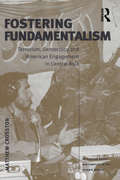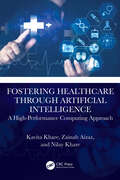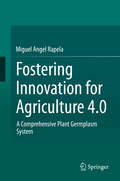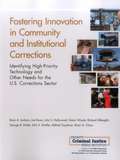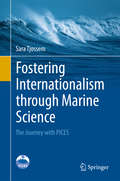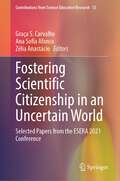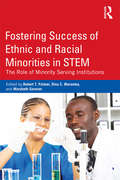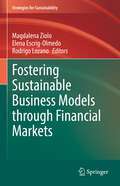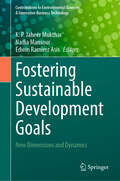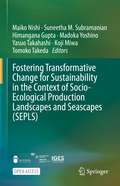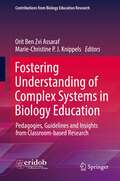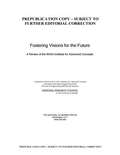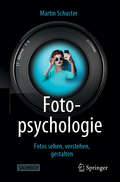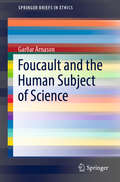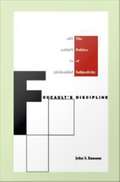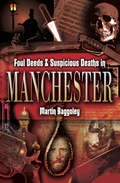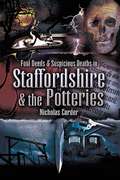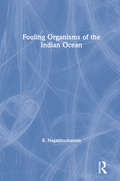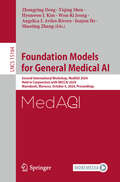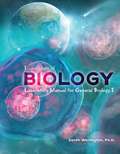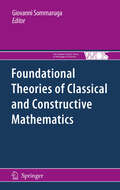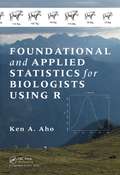- Table View
- List View
Fostering Fundamentalism: Terrorism, Democracy and American Engagement in Central Asia (US Foreign Policy and Conflict in the Islamic World)
by Matthew CrosstonIs the United States, in its fight against terror and pursuit of Osama Bin Laden, recklessly creating conditions in Central Asia to produce the next Bin Laden? Matthew Crosston studies this controversial argument in his political analysis of US foreign policy on Central Asia. He looks specifically at the 'no-man's land nexus' connecting Tajikistan, Uzbekistan and Kyrgyzstan and the heart of Central Asian Islamic radicalism - the Fergana Valley. This book breaks new ground by examining in unflinching detail the unwitting role US foreign policy plays in fomenting that 'hot zone' and extremism, producing a new generation of Islamic radicals. University courses that deal with US foreign policy, international security, terrorism and/or Eurasian politics will want to make this book required reading.
Fostering Healthcare through Artificial Intelligence: A High-Performance Computing Approach
by Kavita Khare Nilay Khare Zainab AizazIn this book, readers can explore the transformative power of artificial intelligence (AI) in reshaping modern healthcare. The book dives deep into how cutting- edge technologies are revolutionizing diagnostics, patient care, and medical research. From the predictive analytics that anticipate disease outbreaks to intelligent systems that enhance clinical decisionmaking, this book reveals how AI technologies are playing a transformative role in healthcare domain. Designed for healthcare professionals and AI enthusiasts, this book presents real- world applications, ethical considerations, and visionary insights from researchers and industry. The book provides readers a comprehensive understanding of AI’s potential to drive meaningful change.This book: Covers high-performance computing field programmable gate array networks for machine learning-based biomedical applications Presents machine learning algorithms for cancer susceptibility, recurrence, and survival prediction Discusses the use of high-performance computing (HPC) in the execution of low-power processors for healthcare devices Demonstrates detailed performance analysis of wearable healthcare devices Highlights the use of Pix2pix generative adversarial networks for mammographically occult breast cancer detection Whether you're navigating the complexities of digital health transformation or simply curious about AI’s role in medicine, Fostering Healthcare through Artificial Intelligence is your essential guide to understanding how technology can foster a healthier, smarter future for all.
Fostering Innovation for Agriculture 4.0: A Comprehensive Plant Germplasm System
by Miguel Angel RapelaThe scientific and technical development of any kind of germplasm is regulated by a vast network of treaties, conventions, international agreements, and national and regional legislation. These regulations govern biotechnological innovations in plants and microorganisms, access to and use of plant genetic resources, and biosafety. This complex mix has made it difficult to arrive at global interpretations, due to overlaps, gaps, ambiguities, contradictions, and lack of consistency. The big picture is even more complex, as a series of scientific developments – gene editing in particular – have in some cases rendered these international regulatory frameworks obsolete.This book puts forward an innovative approach: a “Comprehensive Plant Germplasm System”. The System is a cooperative game theory-based proposal for a binding international convention which would supersede all other conventions, treaties, national and regional legislation covering native varieties and traditional developments, heterogeneous plant varieties, microorganisms, biotechnological inventions, plant genetic resources, and biosafety regulation. In short, it offers a comprehensive framework regarding intellectual property, biosafety, and business regulation and covers all types of germplasm.If applied, the system is expected to yield higher productivity rates in crops and improved food biodiversity, as well as a new paradigm based on the promotion of innovation for “Agriculture 4.0.”
Fostering Innovation in Community and Institutional Corrections: Identifying High-Priority Technology and Other Needs for the U.S. Corrections Sector
by Richard Silberglitt Brian A. Jackson Brian G. Chow John S. Hollywood Dulani Woods Joe Russo George B. Drake John S. Shaffer Mikhail ZaydmanGiven the challenges posed to the U. S. corrections sector, such as tightened budgets and increasingly complex populations under its charge, it is valuable to identify opportunities where changes in tools, practices, or approaches could improve performance. In this report, RAND researchers, with the help of a practitioner Corrections Advisory Panel, seek to map out an innovation agenda for the sector.
Fostering Institutional Development and Vital Change in Africa and Asia
by Fred M. HaywardThis book looks at the question of what makes for successful change in developing countries. It focuses on people at every level in six developing countries in Africa and Asia who have helped foster positive change and development, most of which has been successful. Here, in contrast to so much academic writing on development which focuses on leadership alone, the author tries to get beyond that elite focus and highlight the people at all levels who make change possible. He examines the role and significance of these ordinary citizens and groups as well as leaders. Transformation almost always requires action and support at multiple levels from individuals, communities, and local leaders. The project analyses the cases of Afghanistan, Madagascar, Sierra Leone, Ghana, Pakistan, and South Africa.
Fostering Internationalism through Marine Science
by Sara TjossemThis book describes the work of the North Pacific Marine Science Organization (PICES) since its launch 1992. Mapping the evolution of its agenda gives insight into the development of modern marine science in the context of competing demands of stakeholders within and outside the organization. The opening chapter consider the challenges of marine science as a large scale, and places PICES in the contexts of internationalism and science-based resource management. They also lay out the organization's longstanding focus on the development of climate science and its applications. Subsequent chapters explore the pros and cons of national vs. international science, negotiating the nature of investigation and cooperation across scientific, political and institutional boundaries in the region; national perspectives on purpose, scope, and mandates; assessing two major initiatives undertaken to date; the challenges of incorporating social science into an organization of mainly natural scientists.
Fostering Scientific Citizenship in an Uncertain World: Selected Papers from the ESERA 2021 Conference (Contributions from Science Education Research #13)
by Graça S. Carvalho Ana Sofia Afonso Zélia AnastácioThis edited volume brings together innovative research in the field of Science Education, fostering scientific citizenship in an uncertain world. The nineteen chapters presented in this book address diverse topics, and research approaches carried out in various contexts and settings worldwide, contributing to improving and updating knowledge on science education. The book consists of selected high-quality studies presented at the 14th European Science Education Research Association (ESERA) Conference, held online (due to the Covid-19 pandemic) by the University of Minho, Portugal, between August 30th and September 3rd, 2021. Being of great relevance in contemporary science education, this book stimulates reflection on different approaches to enhance a deeper understanding of how better prepare the coming generations, which is of great interest to science education researchers and science teachers.
Fostering Success of Ethnic and Racial Minorities in STEM: The Role of Minority Serving Institutions
by Dina C. Maramba Marybeth Gasman Robert T. PalmerTo maintain competitiveness in the global economy, United States policymakers and national leaders are increasing their attention to producing workers skilled in science, technology, engineering, and mathematics (STEM). Given the growing minority population in the country, it is critical that higher education policies, pedagogies, climates, and initiatives are effective in promoting racial and ethnic minority students’ educational attainment in STEM. Minority Serving Institutions (MSIs) have shown efficacy in facilitating the success of racial and ethnic minority students in STEM and are collectively responsible for producing nearly one-third of the nation’s minority STEM graduates. In Fostering Success of Ethnic and Racial Minorities in STEM, well-known contributors share salient institutional characteristics, unique aspects of climate, pedagogy, and programmatic initiatives at MSIs that are instrumental in enhancing the success of racial and ethnic minority students in STEM education. This book provides recommendations on institutional practice, policy, and lessons that any institution can use on their campus to foster better retention and persistence among minority students. Higher Education leaders and administrators interested in encouraging achievement among racial and ethnic minority students in STEM education will find this book a welcomed and timely addition to the discourse on promoting minority student success.
Fostering Sustainable Business Models through Financial Markets (Strategies for Sustainability)
by Magdalena Ziolo Rodrigo Lozano Elena Escrig-OlmedoThe aim of this volume is to foster more sustainable business models through financial markets. To that end, it is necessary to know the main global challenges facing financial markets and their impact on creating sustainable value in business models of enterprises in the context of sustainable adaptation. The book focuses on assessing the decision criteria adopted by financial markets in the process of transaction risk valuation, in terms of the presence of Environmental, Social, and Governance (ESG) criteria, and by assessing the impact of including these criteria in the risk assessment process by financial markets in business decisions, leading as a consequence to building new value in the form of a sustainable business model. The book presents global ESG risks facing the financial markets, and discusses how ESG risks are managed and monitored, and how financial markets can measure and operationalize extra-financial risks in its assessment process. The book also analyses ESG risk implications and influences on company behavior, and the actions that companies should take considering the ESG assessment requirements of financial markets. Finally, it provides a comprehensive, structured, and systematic view of how financial markets and companies should adapt and improve their business models. The book provides unique challenges for investors, companies, financial markets, and for our society as a whole, advancing traditional risk management approaches to address global risks.
Fostering Sustainable Development Goals: New Dimensions and Dynamics (Contributions to Environmental Sciences & Innovative Business Technology)
by Nadia Mansour K. P. Jaheer Mukthar Edwin Ramirez AsisThis proceedings is a compilation of results from the International Multi-disciplinary Conference on “Fostering Sustainable Development Goals (SDGs) – New Dimensions and Dynamics”, which took place on July 27th and 28th, 2023, in Bengaluru, India. The volume presents cutting-edge research, analysis, and innovative perspectives that shed light on the United Nations' Sustainable Development Goals (SDGs). It guides policymakers, researchers, academics, and practitioners towards actionable solutions for a sustainable future.In the 21st century, sustainable development is crucial to address global challenges such as climate change, social inequality, technological advancements, and innovative business. The book offers fresh insights and strategies to overcome challenges and accelerate progress towards the SDGs. The book also explores different dimensions of sustainable development, including innovative business models, technological advancements, economic growth, and environmental preservation, providing a holistic understanding of the challenges and opportunities. It analyzes the interconnectedness of the SDGs, guiding policymakers in effective policy design and implementation.Practical case studies and success stories from around the world demonstrate how innovative approaches have achieved tangible progress towards the SDGs. The book inspires readers and showcases the transformative power of sustainable development initiatives.The book emphasizes inclusivity and equity, recognizing the interlinkages between dimensions of sustainable development. The volume explores the challenges faced by marginalized communities, highlighting their empowerment as a catalyst for sustainable development.
Fostering Transformative Change for Sustainability in the Context of Socio-Ecological Production Landscapes and Seascapes (SEPLS)
by Himangana Gupta Maiko Nishi Suneetha M. Subramanian Madoka Yoshino Yasuo Takahashi Koji Miwa Tomoko TakedaThis open access book is a compilation of case studies that provide useful knowledge and lessons that derive from on-the-ground activities and contribute to policy recommendations, focusing on the relevance of social-ecological production landscapes and seascapes (SEPLS) to “transformative change.” The concept of “transformative change” has been gaining more attention to deal with today’s environmental and development problems, whereas both policy and scientific communities have been increasingly calling for transformative change toward sustainable society. The Intergovernmental Science-Policy Platform on Biodiversity and Ecosystem Services (IPBES) has planned to start the so-called “assessment on transformative change” if approved by the IPBES plenary to be held in 2021. At present, the idea of transformative change, including its scope, methodologies, approaches and strategies, are yet to be clarified. By bringing together all of the different concerns and interests in the land/seascape, SEPLS approaches could provide practical and experience-based insights for understanding and gauging transformative change and identifying determinants of such change. This book explores how SEPLS management relates to the idea of transformative change to further the discussion of sustainable transitions in advancing sustainability science. The introductory chapter is followed by case study chapters offering real-world examples of transformative change as well as a synthesis chapter clarifying the relevance of the case study findings to policy and academic discussions. It will be of interest to scholars, policymakers and professionals in the fields related to sustainable development.
Fostering Understanding of Complex Systems in Biology Education: Pedagogies, Guidelines and Insights from Classroom-based Research (Contributions from Biology Education Research)
by Orit Ben Zvi Assaraf Marie-Christine P. J. KnippelsThis book synthesizes a wealth of international research on the critical topic of ‘fostering understanding of complex systems in biology education’. Complex systems are prevalent in many scientific fields, and at all scales, from the micro scale of a single cell or molecule to complex systems at the macro scale such as ecosystems. Understanding the complexity of natural systems can be extremely challenging, though crucial for an adequate understanding of what they are and how they work.The term “systems thinking” has become synonymous with developing a coherent understanding of complex biological processes and phenomena. For researchers and educators alike, understanding how students’ systems thinking develops is an essential prerequisite to develop and maintain pedagogical scaffolding that facilitates students’ ability to fully understand the system’s complexity. To that end, this book provides researchers and teachers with key insights from the current research community on how to support learners systems thinking in secondary and higher education. Each chapter in the book elaborates on different theoretical and methodological frameworks pertaining to complexity in biology education and a variety of biological topics are included from genetics, photosynthesis, and the carbon cycle to ecology and climate change. Specific attention is paid to design elements of computer-based learning environments to understand complexity in biology education.
Fostering Visions for the Future: A Review of the NASA Institute of Advanced Concepts
by National Research Council of the National AcademiesThe NASA Institute for Advanced Concepts (NIAC) was formed in 1998 to provide an independent source of advanced aeronautical and space concepts that could dramatically impact how NASA develops and conducts its missions. Until the program's termination in August 2007, NIAC provided an independent open forum, a high-level point of entry to NASA for an external community of innovators, and an external capability for analysis and definition of advanced aeronautics and space concepts to complement the advanced concept activities conducted within NASA. Throughout its 9-year existence, NIAC inspired an atmosphere for innovation that stretched the imagination and encouraged creativity. As requested by Congress, this volume reviews the effectiveness of NIAC and makes recommendations concerning the importance of such a program to NASA and to the nation as a whole, including the proper role of NASA and the federal government in fostering scientific innovation and creativity and in developing advanced concepts for future systems. Key findings and recommendations include that in order to achieve its mission, NASA must have, and is currently lacking, a mechanism to investigate visionary, far-reaching advanced concepts. Therefore, a NIAC-like entity should be reestablished to fill this gap.
Fotopsychologie: Fotos sehen, verstehen, gestalten
by Martin SchusterEin Bild sagt oft mehr als tausend Worte, und mit dem Fotoapparat ist es leicht, sich eines, oder auch viele Bilder zu machen. Martin Schuster spürt den psychologischen Aspekten der Fotografie nach: Welche Motive werden gewählt? Was verbindet Fotografen und Fotografierte? Was erleben wir beim Betrachten eigener und fremder Fotos? Er zeigt, wie Fotos genutzt werden können, um die Vergangenheit wieder lebendig zu machen und wie Presse- und Werbefotografen mit Fotos an unsere Wünsche und Sehnsüchte appellieren. Hinweise zur Alltagsfotografie ermuntern dazu, ungeachtet künstlerischer Ambitionen die Fotografie für das eigene Leben intensiver und persönlicher zu nutzen. Diese dritte Auflage wurde grundlegend überarbeitet und aktualisiert. Die Möglichkeiten der omnipräsenten Digital- und Handyfotografie werden beleuchtet, ebenso wie der unseren Alltag immer stärker prägende Einfluss der massenhaften bildhaften Kommunikation im Internet. Prof. Dr. Martin Schuster, geb. 1946, Studium der Psychologie, ab 1972 Assistent und Akademischer Rat an der Universität Köln, pensioniert seit 2008.Zahlreiche Veröffentlichungen zu den Themen Kreativität, Kunstpsychologie, Kinderzeichnung und Kunsttherapie.
Foucault and the Human Subject of Science
by Garðar ÁrnasonThis book offers a clear analysis of Foucault’s work on scientific knowledge and its relationship to individuals and society. It suggests a way of using Foucault’s tools for science criticism and resistance, while avoiding the pitfalls of vulgar relativism or irrational anti-science views. Two cases of scientific conflict are considered. The first considers left-handers as subjects of science, in particular studies which purport to show that left-handers die on average younger than right-handers. The second case considers Icelanders as subjects of science in the context of a partly failed attempt to construct a genetic database encompassing the entire nation.The book will be of interest to bioethicists and philosophers who are concerned with the interaction between science and its human subjects, as well as scholars concerned with Foucault’s work on science.
Foucault's Discipline: The Politics of Subjectivity
by John S. RansomIn Foucault's Discipline, John S. Ransom extracts a distinctive vision of the political world--and oppositional possibilities within it--from the welter of disparate topics and projects Michel Foucault pursued over his lifetime. Uniquely, Ransom presents Foucault as a political theorist in the tradition of Weber and Nietzsche, and specifically examines Foucault's work in relation to the political tradition of liberalism and the Frankfurt School. By concentrating primarily on Discipline and Punish and the later Foucauldian texts, Ransom provides a fresh interpretation of this controversial philosopher's perspectives on concepts such as freedom, right, truth, and power. Foucault's Discipline demonstrates how Foucault's valorization of descriptive critique over prescriptive plans of action can be applied to the decisively altered political landscape of the end of this millennium. By reconstructing the philosopher's arguments concerning the significance of disciplinary institutions, biopower, subjectivity, and forms of resistance in modern society, Ransom shows how Foucault has provided a different way of looking at and responding to contemporary models of government--in short, a new depiction of the political world.
Foul Deeds & Suspicious Deaths in Manchester (Foul Deeds & Suspicious Deaths)
by Martin BaggoleyMartin Baggoley was born in Eccles . He spent several years working in London and Salford as a civil servant, before qualifying as a probation officer in 1976. Since then, he has worked in the Greater Manchester area, and during this period gained a masters degree in criminology. He has written for a number of UK and American professional journals on criminal justice issues. His main interest is the history of crime and punishment and for this book, he has combind his professional experience and academic expertise with his interest in local history.
Foul Deeds & Suspicious Deaths in Staffordshire & the Potteries (Foul Deeds & Suspicious Deaths)
by Nicholas CorderIn Foul Deeds and Suspicious Deaths in Staffordshire and the Potteries the chill is brought close to home as each chapter investigates the darker side of humanity in notorious cases of murder, deceit and pure malice that have marked the history of the area. For this journey into a bloody, neglected aspect of the past, Nicholas Corder has selected over 20 episodes that give a fascinating insight into criminal acts and the criminal mind. Recalled here are the Rugeley poisoner William Palmer, who disposed of his victims with strychnine, the vicious assaults on Issac Brooks and the miscarriage of justice that put George Edalji behind bars for three years and brought the creator of the world's greatest fictional detective to his rescue. The Canal boat killing of poor Christina Collins is described in graphic detail, as is the sad case of Thirza Tunstall's baby and the bizarre case of the headless corpse of Hednesford. The human dramas Nicholas Corder explores are often played out in the most commonplace of circumstances, but others are so odd as to be stranger than fiction. His grisly chronicle of the hidden history of staffordshire and the Potteries will be compelling reading for anyone who is interested in the darker side of human nature.
Foul Deeds & Suspicious Deaths in Wigan (Foul Deeds & Suspicious Deaths)
by Mike FletcherFoul Deeds and Suspicious Deaths in and Around Wigan is a detailed guide to the town's darker side, exploring, often in gory detail, Wigan's more sinister heritage, by examining accounts of murder and suspicious deaths from the middle ages through to the twentieth century. Victorian Wigan was a town seemingly overflowing with criminals, and some of the most gruesome cases, recounted from the reports taken from the Wigan Observer and Wigan Examiner, occurred in the second half of the nineteenth century. Many of the cases are without motice or provocation. Domestic crime features highly, often involving Wigan's colliers savagely beating their wives to death, and some of the cases remains unsolved. Each of the cases are covered in detail, documenting the crime, the investigation and inquest, and culminates with the eventual court case and punishment.
Fouling Organisms of the Indian Ocean
by Rachakonda NagabhushanamMarine fouling organisms attach permanently to ship hulls and underwater parts of offshore structures. All maritime nations spend millions, even billions of dollars to get rid of them. Believing that a pooling of knowledge of all aspects of the basic biology of fouling organisms and a re-examination of control technology methods are steps needed for the solution of this problem, the aim of the book is to highlight recent advances in fouling control technology and, at the same time, provide basic information on the biology of fouling organisms found in the Indian Ocean. The book begins by presenting an overview of research done in India on the marine fouling organisms and wood-borers of the Indian Ocean. It them moves through chapters dealing with the seccession of fouling communities, chemical cues in larval settlement, epibiosis, methods of fouling prevention, functional morphology, and distribution of foulers in Indian waters.
Foundation Models for General Medical AI: Second International Workshop, MedAGI 2024, Held in Conjunction with MICCAI 2024, Marrakesh, Morocco, October 6, 2024, Proceedings (Lecture Notes in Computer Science #15184)
by Shaoting Zhang Won-Ki Jeong Yiqing Shen Zhongying Deng Hyunwoo J. Kim Angelica I. Aviles-Rivero Junjun HeThis book constitutes the refereed proceedings from the Second International Workshop on Foundation Models for General Medical AI, MedAGI 2024, held in conjunction with the 27th International conference on Medical Image Computing and Computer Assisted Intervention, MICCAI 2024, in Marrakesh, Morocco in October 2024. The 17 papers included in this book were carefully reviewed and selected from 26 submissions. These papers provide insights into the current landscape of medical AI and foundation models, that can pave the way for the evolution of task-specific medical AI systems into more generalized frameworks capable of tackling a diverse range of tasks, datasets, and domains.
Foundation for Integrating Employee Health Activities for Active Duty Personnel in the Department of Defense
by Christopher Nelson Elizabeth M. Sloss Gary Cecchine Gail Fisher Preethi R. SamaThe authors describe current Department of Defense safety and occupational health programs and health information systems, as well as employee health programs outside of DoD to provide a foundation for considering a more integrated Department of Defense employee health program.
Foundation of Biology: Laboratory Manual for General Biology I
by Sarah WarringtonThis book contains 13 Lab Project Exercises.
Foundational Theories of Classical and Constructive Mathematics
by Giovanni SommarugaThe book "Foundational Theories of Classical and Constructive Mathematics" is a book on the classical topic of foundations of mathematics. Its originality resides mainly in its treating at the same time foundations of classical and foundations of constructive mathematics. This confrontation of two kinds of foundations contributes to answering questions such as: Are foundations/foundational theories of classical mathematics of a different nature compared to those of constructive mathematics? Do they play the same role for the resp. mathematics? Are there connections between the two kinds of foundational theories? etc. The confrontation and comparison is often implicit and sometimes explicit. Its great advantage is to extend the traditional discussion of the foundations of mathematics and to render it at the same time more subtle and more differentiated. Another important aspect of the book is that some of its contributions are of a more philosophical, others of a more technical nature. This double face is emphasized, since foundations of mathematics is an eminent topic in the philosophy of mathematics: hence both sides of this discipline ought to be and are being paid due to.
Foundational and Applied Statistics for Biologists Using R
by Ken A. AhoFull of biological applications, exercises, and interactive graphical examples, Foundational and Applied Statistics for Biologists Using R presents comprehensive coverage of both modern analytical methods and statistical foundations. The author harnesses the inherent properties of the R environment to enable students to examine the code of complica
